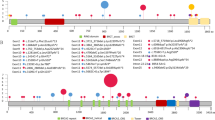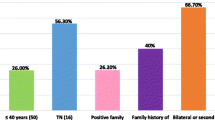Abstract
Purpose
BRCA1/2 mutations represent a high risk of breast cancer and are related to early-onset breast cancer. However, few studies have reported the relationship between BRCA1/2 mutations and their clinical characteristics in early-onset breast cancers. This study is the first article that characterizes the risk factor profiles in Chinese patients selected by the age of onset (≤ 40 years old). We found some differences in the prevalence of germline BRCA1/2 mutations between Asian and Western countries.
Methods
A total of 1371 consecutive unselected Chinese early-onset breast cancer patients were enrolled from the Fujian Medical University Union Hospital, China, and screened for germline BRCA1/2 mutations. Full-exome sequencing in next-generation sequencing technology was performed in all patients to examine BRCA1/2 mutations.
Results
In our study, 25 (1.8%) and 61 (4.4%) patients were identified with BRCA1 and BRCA2 mutations, respectively, among the unselected early-onset breast cancer patients. BRCA1 mutations were associated with pregnancies (p = 0.026), and BRCA1 carriers had a higher likelihood of being HR positive (p < 0.001), HER2 negative (p < 0.001), or high grade (p = 0.002) than noncarriers. Among BRCA2 mutations, the age of onset was younger in carriers than in noncarriers (p = 0.017), and BRCA2 carriers were more likely to have lymph node metastasis (p = 0.004). HR-positive or HER2-negative patients were likely to be positive for BRCA2 mutations (p < 0.001). Overall, 14 BRCA1 mutations and 8 BRCA2 mutations were first reported in our study
Conclusion
This study provided some information about the spectrum of BRCA1/2 mutations and characterized the risk factors for early-onset breast cancer in China.


Similar content being viewed by others
References
Assi HA, Khoury KE, Dbouk H, Khalil LE, Mouhieddine TH, El Saghir NS (2013) Epidemiology and prognosis of breast cancer in young women. J Thorac Dis 5(1):S2–S8
Han W, Kim SW, Park IA et al (2004) Young age: an independent risk factor for disease-free survival in women with operable breast cancer. BMC Cancer 4(1):82. https://doi.org/10.1186/1471-2407-4-82
Radecka B, Litwiniuk M et al (2016) Breast cancer in young women. Ginekol Pol 87(9):659–663
Shuch B, Vourganti S, Ricketts CJ, Middleton L, Peterson J, Merino MJ et al (2014) Defining early-onset kidney cancer: implications for germline and somatic mutation testing and clinical management. J Clin Oncol 32(5):431–437
Rosenberg Shoshana M, Kathryn J, Ruddy Rulla M et al (2016) BRCA1 and BRCA2 mutation testing in young women with breast cancer. JAMA Oncol 2(6):730–736
Chuang C, Sun S, Jing-Ping Y, Yao-Huai W, Yi T, Feng Y et al (2016) Characteristics of breast cancer in Central China, literature review and comparison with USA. Breast 30:208–213
Anders CK, Hsu DS, Broadwater G et al (2008) Young age at diagnosis correlates with worse prognosis and defines a subset of breast cancers with shared patterns of gene expression. J Clin Oncol 26:3324–3330
Soley B, Banu A (2016) BRCA mutation genetic testing implications in the United States. Breast 31:224–232
Szabo CI (1997) Population genetics of BRCA1 and BRCA2. Am J Hum Genet 60(5):1013–1020
Young SR, Pilarski RT, Donenberg T et al (2009) The prevalence of BRCA1 mutations among young women with triple negative breast cancer. BMC Cancer 9:1–5
Anglian Breast Cancer Study Group (2000) Prevalence and penetrance of BRCA1 and BRCA2 mutations in a population-based series of breast cancer cases. Br J Cancer 83(10):1301–1308
Yang XR, Devi BCR, Sung H et al (2017) Prevalence and spectrum of germline rare variants in BRCA1/2 and PALB2 among breast cancer cases in Sarawak. Breast Cancer Res Treat 165(3):687–697
Rennert G, Bisland-Naggan S, Barnett-Griness O et al (2007) Clinical outcomes of breast cancer in carriers of BRCA1 and BRCA2 mutations. N Engl J Med 357(2):115–123
Verhoog LC, Brekelmans CT, Seynaeve C et al (1998) Survival and tumour characteristics of breast cancer patients with germline mutations of BRCA1. Lancet 351:316–321
Huzarski T, Byrski T, Gronwald J et al (2013) Ten year survival in patients with BRCA1-negative and BRCA1-positive breast cancer. J Clin Oncol 31:3191–3196
Bordeleau L, Panchal S, Goodwin P (2010) Prognosis of BRCA-associated breast cancer: a summary of evidence. Breast Cancer Res Treat 119:13–24
Claus EB, Schildkraut JM, Thompson WD, Risch NJ (1996) The genetic attributable risk of breast and ovarian cancer. Cancer 77:2318–2324
Jie S, Hua M, Lu Y, Meng L, Xie Y et al (2017) Germline mutations in cancer susceptibility genes in a large series of unselected breast cancer patients. Clin Cancer Res 23(20):6113–6119
Lang GT, Shi JX, Hu X, Zhang CH, Shan L, Shao ZM (2017) The spectrum of BRCA mutations and characteristics of BRCA-associated breast cancers in China: screening of 2991 patients and 1043 controls by next-generation sequencing. Int J Cancer 141(1):129–142
Rebbeck TR, Mitra N, Wan F, Sinilnikova OM, Healey S, McGuffog L, Mazoyer S, Chenevix-Trench G, Easton DF, Antoniou AC, Nathanson KL (2015) The CIMBA consortium, association of type and location of BRCA1 and BRCA2 mutations with risk of breast and ovarian cancer. JAMA 313(13):1347–1361
Wojcik P, Jasiowka M, Strycharz E, Sobol M, Hodorowicz-Zaniewska D, Skotnicki P, Pierzchalski P (2016) Recurrent mutations of BRCA1, BRCA2 and PALB2 in the population of breast and ovariancancer patients in Southern Poland. Hered Cancer Clin Pract 14:5
Caux-Moncoutier V, Pages-Berhouet S, Michaux D, Asselain B, Houdayer C (2009) Impact of BRCA1 and BRCA2 variants on splicing: clues from an allelic imbalance study. Eur J Hum Genet 17(11):1471–1480
Kim YC, Zhao L, Zhang H, Huang Y, Cui J, Xiao F, Downs B, Wang SM (2016) Prevalence and spectrum of BRCA germline variants in mainland Chinese familial breast and ovarian cancer patients. Oncotarget 7(8):9600–9612
Yang X, Wu J, Lu J, Liu G, Di G, Chen C, Sun M, Hu Z (2015) Identification of a comprehensive spectrum of genetic factors for hereditary breast cancer in a Chinese population by next-generation sequencing. PLoS ONE 10(4):30125571
Li WF, Hu Z, Rao NY, Song CG, Zhang B, Shao ZM (2008) The prevalence of BRCA1 and BRCA2 germline mutations in high-risk breast cancer patients of Chinese Han nationality: two recurrent mutations were identified. Breast Cancer Res Treat 110(1):99–109
Suter NM, Ray RM, Hu YW, Lin MG, Porter P (2004) BRCA1 and BRCA2 mutations in women from Shanghai China. Cancer Epedemiol Biomarkers Prev 13(2):181–189
Bergman A, Flodin A, Engwall Y, Arkblad EL, Berg K, Einbeigi Z (2005) A high frequency of germline BRCA1/2 mutations in western Sweden detected with complementary screening techniques. Fam Cancer 4(2):89–96
Zhang J, Sun J, Chen J, Yao L, Ouyang T, Li J, Xie Y (2016) Comprehensive analysis of BRCA1 and BRCA2 germline mutations in a large cohort of 5931 Chinese women with breast cancer. Breast Cancer Res Treat 158(3):455–462
Lecarpentier J, Noguès C, Mouret-Fourme E, Gauthier-Villars M, Lasset C, Fricker JP (2012) Variation in breast cancer risk associated with factors related to pregnancies according to truncating mutation location, in the French National BRCA1 and BRCA2 mutations carrier cohort(GENEPSO). Breast Cancer Res 14(4):R99
Kast K, Rhiem K, Wappenschmidt B, Hahnen E, Hauke J, Bluemcke B, Zarghooni V, Herold N, Ditsch N, Kiechle M, Braun M, Fischer C et al (2016) Prevalence of BRCA1/2 germline mutations in 21401 families with breast and ovarian cancer. J Med Genet 53:465–471
Peto J, Collins N, Barfoot R, Seal S, Warren W, Rahman N, Easton DF, Evans C, Deacon J, Stratton MR (1999) Prevalence of BRCA1 and BRCA2 gene mutations in patients with early-onset breast cancer. J Natl Cancer Inst 91:943–949
Copson ER, Maishman TC, Tapper WJ, Cutress RI, Greville-Heygate S (2018) Germline BRCA mutation and outcome in young-onset breast cancer (POSH): a prospectivecohort study. Lancet Oncol 19(2):169–180
Bayraktar S, Amendola L, Gutierrez-Barrera AM, Hashmi SS (2014) Clinicopathologic characteristics of breast cancer in BRCA-carriers and non-carriers in women 35 years of age or less. Breast 23(6):770–774
Brown KL, Hutchison R, Zinberg E, McGovern MM (2005) Referral and experience with genetic testing among women with early onset breast cancer. Genet Test 9(4):301–305
Ruddy KJ, Gelber S, Shin J, Garber JE (2010) Genetic testing in young women with breast cancer: results from a web-based survey. Ann Oncol. 21(4):741–747
Peters N, Domchek SM, Rose A, Polis R, Stopfer J, Armstrong K (2005) Knowledge, attitudes, and utilization of BRCA1/2 testing among women with early-onset breast cancer. Genet Test 9(1):48–53
Yao L, Sun J, Zhang J, He Y, Ouyang T, Xie Y (2016) Breast cancer risk in Chinese women with BRCA1 or BRCA2 mutations. Breast Cancer Res Treat 6(3):441–445
Moller P, Evans DG, Reis MM et al (2007) Surveillance for familial breast cancer: differences in outcome according to BRCA mutation status. Int J Cancer 121:1017–1020
(c)National Comprehensive Cancer Network, Inc., 2015. NCCN clinical practice guidelines in oncology (NCCN Guidelines®) for breast and/or ovarian cancer genetic assessment V.1.2019. National Comprehensive Cancer Network®, NCCN®, NCCN Guidelines®, and all other NCCN Content are Trademarks Owned by the National Comprehensive Cancer Network, Inc.
Lakhani SR, Jacquemier J, Sloane JP et al (1998) Multifactorial analysis of differences between sporadic breast cancers and cancers involving BRCA1 and BRCA2 mutations. J Natl Cancer Inst 90(15):1138–1145
Phillips KA (2000) Immunophenotypic and pathologic differences between BRCA1 and BRCA2 hereditary breast cancers. J Clin Oncol 18(21):107S–112S
Narod SA, Foulkes WD (2004) BRCA1 and BRCA2: 1994 and beyond. Nat Rev Cancer 4(9):665–676
Bauer KR, Brown M, Cress RD, Parise CA, Caggiano V (2007) Descriptive analysis of estrogen receptor (ER)-negative, progesterone receptor (PR)-negative, and HER2-negative invasive breast cancer, the so-called triple-negative phenotype: a population-based study from the California Cancer Registry. Cancer 109(9):1721–1728
Frank TS, Deffenbaugh AM, Reid JE et al (2002) Clinical characteristics of individuals with germline mutations in BRCA1 and BRCA2: analysis of 10,000 individuals. J Clin Oncol 20(6):1480–1490
Gonzalez-Angulo AM, Broglio K, Kau SW et al (2005) Women age ≤ 35 years with primary breast carcinoma: disease features at presentation. Cancer 103(12):2466–2472
Tryggvadottir L, Tulinius H, Eyfjord JE, Sigurvinsson T (2002) Breast cancer risk factors and age at diagnosis: an Icelandic cohort study. Int J Cancer 98(4):604–608
Author information
Authors and Affiliations
Corresponding author
Ethics declarations
Conflict of interest
The authors declare that they have no conflicts of interest.
Ethical approval
All the procedures performed in studies involving human participants adhere to the Ethical Standards of the Institutional and/or National Research Committee and with the Helsinki Declaration and its later amendments or comparable ethical standards.
Informed consent
The requirement for informed consent was waived because of the low risk posed by this investigation.
Additional information
Publisher's Note
Springer Nature remains neutral with regard to jurisdictional claims in published maps and institutional affiliations.
Rights and permissions
About this article
Cite this article
Chen, L., Fu, F., Huang, M. et al. The spectrum of BRCA1 and BRCA2 mutations and clinicopathological characteristics in Chinese women with early-onset breast cancer. Breast Cancer Res Treat 180, 759–766 (2020). https://doi.org/10.1007/s10549-020-05573-x
Received:
Accepted:
Published:
Issue Date:
DOI: https://doi.org/10.1007/s10549-020-05573-x




